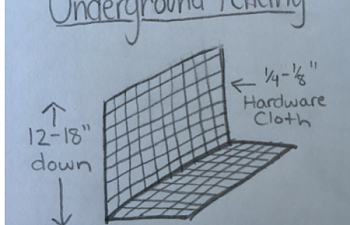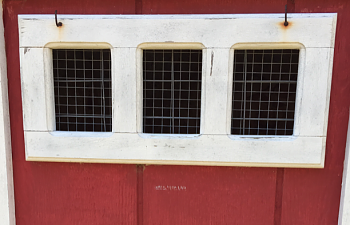Keeping chickens predators away from chickens can be extremely difficult. However, a secure coop is a good start. Here are some ideas on how to "predator proof" your coop and run.
Flooring
One way predators such as foxes and dogs can gain entrance is by digging under the coop. The best way to prevent this is to pour a cement floor in the coop. Another solution is to raise the coop off the ground. However, there is still a concern of an animal chewing through the flooring. A double layer of plywood with hardware cloth is effective protection, and is a fairly simple adaptation for an existing coop.

A raised coop can prevent digging predators
Windows
Windows are an important source of ventilation in the hot summer months. However, they can also be a point of entry for predators. Predators such as weasels and snakes can get in through an incredibly small space, so all windows should be covered with ¼ to ½” hardware cloth. It is also important to cover any holes in the coop for the same reason.

Hardware cloth over windows
Latches
Providing secure latches on all doors, including nest boxes, is very important. Raccoons are able to open simple latches, so a sliding latch will need extra protection. A hasp latch secured by a carabiner is simple to open for people yet is secure from predators. If there is also a concern over theft, a padlock will suffice.

Fencing
Ironically, chicken wire is not the best fencing for housing chickens. The holes in chicken wire are large enough to let in small predators such as weasels and snakes and the fence is weak enough to allow larger predators access. The ideal fence is ¼ to ½” hardware cloth. Digging should also be a consideration in the run. To prevent predators from gaining entry, hardware cloth should be buried 12-18” deep and at least 6 inches out in an “L” or “J” shape, and then covered with soil. If the run has no roof or netting, the fence be at least 6 feet tall, which should be enough to prevent chickens from flying out and predators such as foxes from jumping in.

A model of buried fencing
Roofing
The top of the run should also be covered in order to prevent attacks from hawks and the like. At the very least, netting is required to prevent attacks. A net of baling twine can also be used over the top as a deterrent. Hanging CDs or wind chimes may also deter flying predators.

Hanging CDs can scare hawks
Free Ranging
Free ranging has many positive aspects, but is also very dangerous. An entirely open yard leaves chickens vulnerable to flying predators. So, it is important to provide bushes for chickens to hide under. If there are no bushes in your yard, you can provide other hiding places like a few 50-gallon barrels cut in half lengthwise and placed on the ground. It is also advisable to keep chickens inside before it gets dark and predators are more active.
Attractants
Snakes will eat eggs (and chicks) and rats will find spilled feed, so it is important to collect eggs daily and ensure that the area around the coop is clean and that feed is stored in a rat-proof container.
Guard Animals
Guard animals can be used as a deterrent to predators. One of the most common guard animals is a rooster. A rooster will attempt to protect the flock and will likely fight or attempt to alert the hens of danger. A guard dog is also a possibility, though training will take some expertise. If not properly trained, a guard dog can become a danger to the chickens.
Nighttime Protection
Nighttime is the most vulnerable time for chickens as they are practically blind in low lighting. Additionally, many predators are nocturnal, so it is very important that from dusk to dawn, chickens are in a secure coop. If you are unable to close the pophole to the coop every night, an automated door can let the chickens out in the morning and shut them in at night. There are many predator deterrents on the market. Some products such as Nite Guard are meant to mimic the look of another predator’s eyes, which is said to deter other predators. A motion-activated light may also help, and a game cam can be useful in identifying a predator.
Predator Protection for the Coop
Flooring
One way predators such as foxes and dogs can gain entrance is by digging under the coop. The best way to prevent this is to pour a cement floor in the coop. Another solution is to raise the coop off the ground. However, there is still a concern of an animal chewing through the flooring. A double layer of plywood with hardware cloth is effective protection, and is a fairly simple adaptation for an existing coop.
A raised coop can prevent digging predators
Windows
Windows are an important source of ventilation in the hot summer months. However, they can also be a point of entry for predators. Predators such as weasels and snakes can get in through an incredibly small space, so all windows should be covered with ¼ to ½” hardware cloth. It is also important to cover any holes in the coop for the same reason.
Hardware cloth over windows
Latches
Providing secure latches on all doors, including nest boxes, is very important. Raccoons are able to open simple latches, so a sliding latch will need extra protection. A hasp latch secured by a carabiner is simple to open for people yet is secure from predators. If there is also a concern over theft, a padlock will suffice.
Predator Protection for the Outside Run
Fencing
Ironically, chicken wire is not the best fencing for housing chickens. The holes in chicken wire are large enough to let in small predators such as weasels and snakes and the fence is weak enough to allow larger predators access. The ideal fence is ¼ to ½” hardware cloth. Digging should also be a consideration in the run. To prevent predators from gaining entry, hardware cloth should be buried 12-18” deep and at least 6 inches out in an “L” or “J” shape, and then covered with soil. If the run has no roof or netting, the fence be at least 6 feet tall, which should be enough to prevent chickens from flying out and predators such as foxes from jumping in.
A model of buried fencing
Roofing
The top of the run should also be covered in order to prevent attacks from hawks and the like. At the very least, netting is required to prevent attacks. A net of baling twine can also be used over the top as a deterrent. Hanging CDs or wind chimes may also deter flying predators.
Hanging CDs can scare hawks
Other Considerations
Free Ranging
Free ranging has many positive aspects, but is also very dangerous. An entirely open yard leaves chickens vulnerable to flying predators. So, it is important to provide bushes for chickens to hide under. If there are no bushes in your yard, you can provide other hiding places like a few 50-gallon barrels cut in half lengthwise and placed on the ground. It is also advisable to keep chickens inside before it gets dark and predators are more active.
Attractants
Snakes will eat eggs (and chicks) and rats will find spilled feed, so it is important to collect eggs daily and ensure that the area around the coop is clean and that feed is stored in a rat-proof container.
Guard Animals
Guard animals can be used as a deterrent to predators. One of the most common guard animals is a rooster. A rooster will attempt to protect the flock and will likely fight or attempt to alert the hens of danger. A guard dog is also a possibility, though training will take some expertise. If not properly trained, a guard dog can become a danger to the chickens.
Nighttime Protection
Nighttime is the most vulnerable time for chickens as they are practically blind in low lighting. Additionally, many predators are nocturnal, so it is very important that from dusk to dawn, chickens are in a secure coop. If you are unable to close the pophole to the coop every night, an automated door can let the chickens out in the morning and shut them in at night. There are many predator deterrents on the market. Some products such as Nite Guard are meant to mimic the look of another predator’s eyes, which is said to deter other predators. A motion-activated light may also help, and a game cam can be useful in identifying a predator.
Thanks for reading! 



